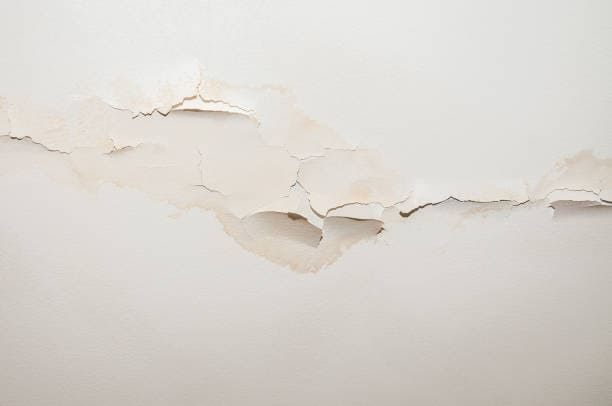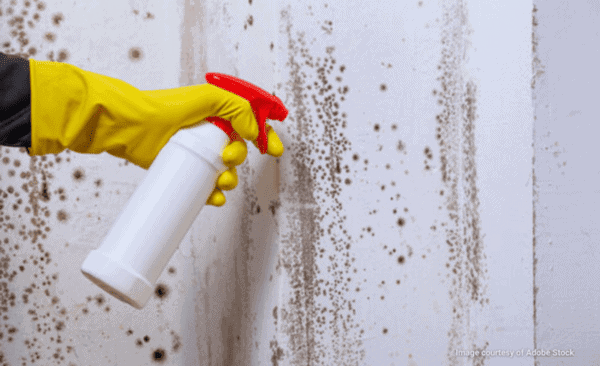Trying to figure out if there is mold in the walls of your home can be really worrying! How would you even know it’s there? It’s inside the wall where you can’t see it! We understand this fear; we help people remedy it every day. We’re Cleaner Guys, a professional mold inspection and mold removal company. In this article, we’re going to show you how to determine if there may be mold in your walls.
Let real mold experts answer the question “Is there mold in my walls?”
Table of Contents
- 10 Signs That There May Be Mold in Your Walls
- Is Mold Inside Walls Dangerous?
- What Is Mold?
- Why Is There Mold in My House?
- How to Remove Mold in Walls
- How to Prevent Mold in Walls in the Future
- Key Takeaways
10 Signs That There May Be Mold in Your Walls
This is our definitive list of how to check for mold in the walls. We’ve been inspecting mold and removing it for more than 20 years. These are all the best signs we know of.
- Odor. Mold has a distinctive, strong, pungent, musty smell. Pay attention to if you smell anything odd or musty near any walls in your home.
- Discoloration. A sign of water damage and mold in walls is brown or grey discolored staining on a wall.
- Bubbling, cracking, or wrinkling in the wall paint. This sign often accompanies discoloration, and is a very strong sign of water damage — and therefore mold — in your wall.
- Soft or squishy walls. This is a clear indication that the drywall is saturated with water, which means mold growth.
- Dripping or gushing sounds inside the wall. This is a clear indication of a leak or burst pipe inside the wall. This is water damage, which will cause mold within 24-48 hours.
- Visible grey, green, black, or brown spots on the wall. This is actual mold. If you can see it on the outside of the wall, it usually means that the mold has spread much farther behind the wall.
- Allergy and cold symptoms. Reactions to mold spores can include a persistent runny nose, coughing, unusual amounts of sneezing, itchy skin or eyes, headaches, and more.
- Persistent headaches can be a strong sign of mold in your house, especially if you don’t have a history of headaches or migraines.
- Trouble sleeping can be another possible sign of mold in your home.
- Previous water damage. Excess moisture in your home can breed mold within 24-48 hours. If you’ve had any kind of water damage in the past, like a leak or an overflow, and it wasn’t cleaned up by a professional water damage mitigation company, you probably have mold.

Is Mold Inside Walls Dangerous
Most molds are not dangerous, but a couple of species are. The vast majority of mold species are called allergenic molds, because they are not toxic or dangerous, but they do cause mold allergy and mold sickness symptoms in many people (such as the symptoms described above). However, there is a species of black mold called Stachybotrys chartarum that is extremely toxic and dangerous, and should never be cleaned or treated by anyone but a professional.
Since it is nearly impossible for a layperson to distinguish between an allergenic mold and a toxic mold species, we strongly advise you to not attempt to clean any mold yourself. Toxic molds like Stachybotrys chartarum can cause such effects as vomiting, nose bleeds, hemorrhaging, and worse.
What is Mold?
Mold is a fungus, an organism distinct from both plants and animals. It grows wherever it can find moisture, oxygen, and a food source it can absorb. This means that mold is most commonly found in areas with high levels of condensation (like bathrooms), and anywhere there is water damage, like a leak or a flood.
Mold spores are floating around in the air all the time, indoors and outdoors, just like dust particles and bacteria. People don’t get sick from the spores usually floating around in the air because the concentration of spores is too low to cause a reaction in the body. However, wherever mold spores find excess moisture, like from a leak or condensation, they will land and begin to root and grow. Once mold starts rooting and growing on a surface, it begins releasing its own spores. This greatly increases the concentration of mold spores in the air, which is why people living near mold growth can get sick.
Why Is There Mold in My House? What Causes Mold?
All mold needs to grow is moisture, oxygen, and organic material to feed on. This means that the circumstances that cause mold are mostly related to water damage. Water damage includes, but is not limited to:
- Leaking plumbing
- Burst pipes
- Leaking water supply lines to refrigerators and washing machines
- Minor floods, such as from an overflowing toilet or sink
- Major floods, such as from natural disasters
- Leaking roof
- Water heater bursting or failure
- Clogs or sewage backups
- Fire sprinklers
- Water from fire hoses used to douse house fires

How to Remove Mold in Walls
We strongly advise against attempting to remove mold inside your walls yourself. Removing mold inside walls usually requires cutting away the drywall, potentially removing any infected framing, properly disposing of all mold-infested materials, and cleaning the area thoroughly with chemical solutions that will actually kill the mold. Most untrained laypeople should not attempt any of these steps, because they should be done in a specific and proper way in order to ensure complete mold removal.
Additionally, most laypeople cannot determine whether the mold is a toxic species or a fairly harmless one. A layperson attempting to remove mold that they don’t know is extremely toxic can lead to terrible side effects (see the section “Is Mold Inside Walls Dangerous”).
Can I Use Bleach to Clean Mold Inside Walls?
While many publications on the internet claim that cleaning mold with bleach is effective, most professional mold removal companies like Cleaner Guys disagree. We strongly advise against attempting mold removal with bleach. It is so caustic that it almost always damages whatever material it touches, and furthermore, it usually doesn’t penetrate the material deeply enough to thoroughly destroy the mold.
Click here to read more about our stance against using bleach on mold.
Can I Use Vinegar to Clean Mold Inside Walls?
Vinegar can be useful for killing mold in some circumstances, however, it does not work in most cases. Vinegar can kill mold, however, it does not penetrate very deeply into whatever material it encounters. Most cases of mold infestation we have seen in our 20+ years of experience are too deep and too large for mold to be 100% effective. If the mold is only surface level (like mildew), and is smaller than 1 square foot, then vinegar may be successfully effective. However, on mold that covers areas larger than that, it is usually not 100% effective, and the mold returns eventually.
Click here to read more about our advice for using vinegar on mold.
How to Prevent Mold in Walls in the Future
Prevention of mold growth in the future is naturally one of the biggest things on the mind of anyone worried about mold. These are the steps we strongly recommend to avoid mold in the future.
- Keep Indoor Humidity Low. We agree with the CDC’s recommendation to keep your indoor humidity ideally lower than 50%. You can achieve this either with proper ventilation or a dehumidifier. Remember: mold needs moisture to grow, so don’t give it any!
- Take Care of Leaks Immediately. If you live in a rental home or apartment, alert your landlord about leaks and damaged window sealings immediately, pressing them about it as necessary. If you own your home or business, it’s up to you to stay on top of any plumbing issues and leaks.
- Ventilation, ventilation, ventilation! Try to have some kind of airflow in every room. Ceiling fans, freestanding fans, and even opening a window will do. Stagnant air encourages mold growth.
- Regular Cleaning. Mold feeds on organic materials like dust and crumbs. Cleaning all those away makes your home more inhospitable to mold.
Key Takeaways
You’ve learned in this article our top 10 strong signs that you can use to help you determine if there is mold in the walls of your home. These include allergy and cold symptoms (which are actually mold sickness), bubbling, peeling, cracking, or discolored areas of your walls, musty odors, dripping sounds inside the walls, and more. You have also learned about what mold is, how to stop it, how to clean it, and when to call a professional mold removal company.
If you’re not sure how to successfully find a good, trustworthy mold removal company near you, use our handy guide to help you find just the right company for you.
If you find yourself in the unfortunate position of needing a professional mold inspection or mold removal company in Western Washington State, consider Cleaner Guys as a high-quality, well-trusted option. We’re proud to boast award-winning customer service, lower prices than others, and top-notch workmanship! Contact us today through the menu at the top of your screen.

Disclaimer: This article is for informational purposes only. No part of this article is medical or legal advice, and may not be used as such. For all serious medical matters, consult your doctor. For all serious legal matters, consult your legal advisor. This article contains Cleaner Guys’ experience and opinions only.


